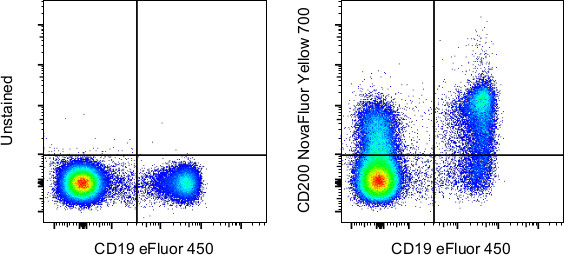Invitrogen
CD200 Monoclonal Antibody (OX104), NovaFluor™ Yellow 700, eBioscience™
FIGURE: 1 / 2
CD200 Antibody (H038T03Y06-A) in Flow


Product Details
H038T03Y06-A
Species Reactivity
Host/Isotype
Class
Type
Clone
Conjugate
Excitation/Emission Max
Form
Concentration
Purification
Storage buffer
Contains
Storage conditions
RRID
Product Specific Information
Description: The monoclonal antibody OX104 recognizes human CD200 also known as OX2. CD200 is a member of the Ig superfamily with 2 Ig domains, a transmembrane and cytoplasmic domain. CD200 is expressed on resting and activated B cells, a subset of resting and activated T cells, keratinocytes, peripheral and central nerve cells, follicular dendritic cells and ovarian cells. The interaction with CD200R results in macrophage activation (IL-6 production), inhibition of mast cell degranulation along with reduced TNFalpha and IL-13 secretion and overall attenuation of the activation status of lymphocytes. A role has also been suggested in maternal tolerance as expression of CD200 is also present on the trophoblast.
Each product contains 1 vial of NovaFluor conjugate and 1 vial of CellBlox Plus Blocking Buffer .
Applications Reported: This OX104 antibody has been reported for use in flow cytometric analysis.
Applications Tested: This OX104 antibody has been tested by flow cytometric analysis of normal human peripheral blood cells. This may be used at less than or equal to 0.06 µg per test. A test is defined as the amount (µg) of antibody that will stain a cell sample in a final volume of 100 µL. Cell number should be determined empirically but can range from 10^5 to 10^8 cells/test. It is recommended that the antibody be carefully titrated for optimal performance in the assay of interest.
NovaFluor dyes are not compatible with DNA intercalating viability dyes. Do not use viability dyes such as propidium iodide, 7-actinomycin D (7-AAD) and DAPI. Invitrogen LIVE/DEAD Fixable Dead Cell stains are recommended for use with NovaFluor dyes.
This NovaFluor conjugate has been updated to ship with CellBlox Plus Blocking Buffer (Cat. No. (C001T06F01)). This buffer contains formulation improvements over CellBlox. CellBlox Plus Blocking Buffer is required for optimal staining with NovaFluor conjugates and should be used in all experiments where NovaFluor conjugates are used. Whenever possible, we recommend adding CellBlox Plus Blocking Buffer to antibody cocktails/master mixes prior to combining with cells. Add 5 µL per sample (regardless of the number of NovaFluors in your panel) to use the antibody cocktail as intended. For single-color controls, use 5 µL of CellBlox Blocking Buffer per 100 µL of cell sample containing 10^3 to 10^8 cells.
NovaFluor conjugates are based on Phiton™ technology utilizing novel nucleic acid dye structures that allow for engineered fluorescent signatures with consideration for spillover and spread impacts. Learn more
Excitation: 552 nm; Emission: 700 nm; Laser: 561 nm (Yellow) Laser
Target Information
CD200 is a type-1 membrane glycoprotein that contains two immunoglobulin domains, and belongs to the immunoglobulin superfamily. CD200 is a broadly distributed cell surface glycoprotein that interacts with a receptor on myeloid cells (CD200R) and is implicated in locally preventing macrophage activation. Distant, but recognizable, homologues of CD200 have been identified in many herpesviruses and poxviruses. Studies of the related genes in mouse and rat suggest that CD200 may regulate myeloid cell activity and delivers an inhibitory signal for the macrophage lineage in diverse tissues. Multiple alternatively spliced transcript variants that encode different isoforms of CD200 have been found. Diseases associated with CD200 dysfunction include Mantle Cell Lymphoma and Primary Hypertrophic Osteoarthropathy.
For Research Use Only. Not for use in diagnostic procedures. Not for resale without express authorization.
How to use the Panel Builder
Watch the video to learn how to use the Invitrogen Flow Cytometry Panel Builder to build your next flow cytometry panel in 5 easy steps.
References (0)
Bioinformatics
Protein Aliases: antigen identified by monoclonal antibody MRC OX-2; CD200; CD200 antigen; OX-2 membrane glycoprotein
Gene Aliases: CD200; MOX1; MOX2; MRC; My033; OX-2
UniProt ID: (Human) P41217
Entrez Gene ID: (Human) 4345

Performance Guarantee
If an Invitrogen™ antibody doesn't perform as described on our website or datasheet,we'll replace the product at no cost to you, or provide you with a credit for a future purchase.*
Learn more
We're here to help
Get expert recommendations for common problems or connect directly with an on staff expert for technical assistance related to applications, equipment and general product use.
Contact tech support

